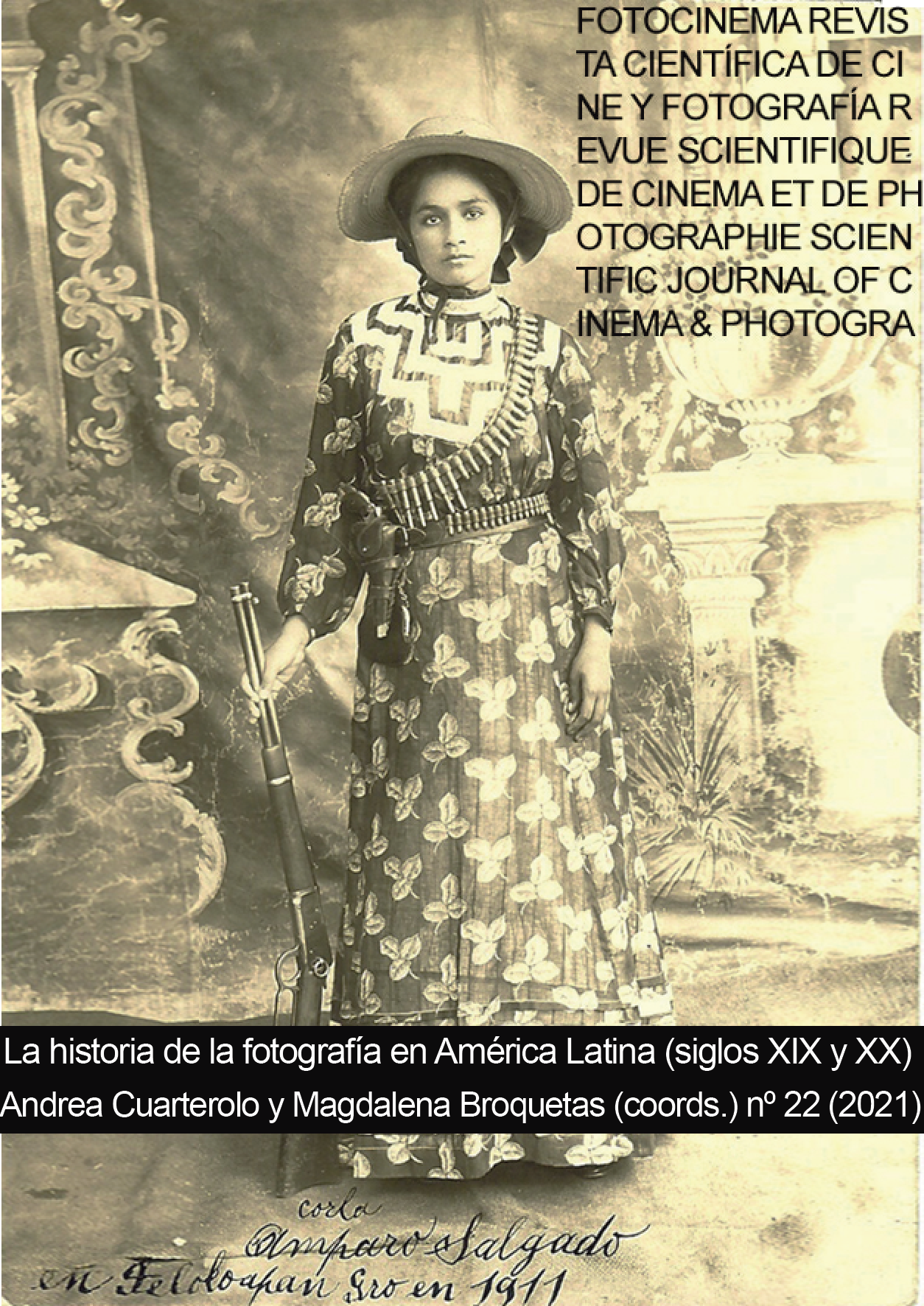From studio photographer to fotocinero and from photographic studio to the street: decadency or democratization of the social use of photography
Keywords:
Cultural history, visual studies, studio photography, street photography, fotocineAbstract
This article seeks to put into dialogue the reflection that Edward Goyeneche makes in his book Photography and society on studio photography, with a historiography of street photography or photo theater, not only as a visual process in itself, but also as a intentional mental phenomenon towards a specific act and practice, with the purpose of understanding the social uses that photography was given by studio photographers and fotocineros, from the social positions and situations that these agents and their agency circumvented within the aesthetic character of social differentiation, while their habits and practices developed between the rise and fall of studio photography and the democratization of street photography. Studio and street photographers have become a research model for visual culture since they have contributed to the construction of the visual regime of modernity, achieving the systematization of the gaze within an ethical statute of the photographic image. immersed in a specific social context.
Downloads
Metrics
Publication Facts
Reviewer profiles N/A
Author statements
Indexed in
-
—
- Academic society
- N/A
- Publisher
- Universidad de Málaga
References
Ávila, A. (2018). Pasos Modernos. Las fotografías callejeras como testimonio de la modernidad en Bogotá, 1940-1970 (tesis doctoral). Bogotá: Universidad de los Andes.
Ballenger, H. (2014). Photography: A communication tool (tesis del Master of Arts Education). Atlanta: Georgia State University.
Belov, A (2017). Contemporary street photography. Its place between art and documentary in the era of digital ubiquity (tesis del Master in Digital Communication and Culture). Oslo: University of Applied Sciences of Oslo.
Benjamin, W. (2018). Pequeña historia de la fotografía. En J. Ibáñez, Iluminaciones (pp. 75-76). Barcelona: Taurus.
Bourdieu, P. (1979). La distinción: Criterios y bases sociales del gusto. Títulos y cuarteles de nobleza cultural. Madrid: Taurus.
Bourdieu, P. (2010). El sentido social del gusto: Elementos para una sociología de la cultura. Buenos Aires: Editorial Siglo XX.
Burke, P. (2005). Visto y no visto. El uso de la imagen como documento histórico. Barcelona: Crítica.
Catalá, J. M. (2008). La forma de lo real: Introducción a los estudios visuales. Barcelona: Editorial UOC.
Colorado, O. (2013). Fotografía de calle: Dossier especial. Recuperado de https://oscarenfotos.com/2013/11/30/fotografia-de-calle/
Foster, H. (2001). El retorno de lo real: La vanguardia a finales de siglo. Madrid: Akal.
García, M. (2010). Entre la fotografía documental y la fotografía callejera: Marginalidad y género. Laocoonte: Revista de Estética y Teoría de las Artes, 5, 181-201.
García de Molero, Í., y Farías de Estany, J. (2007). La especificidad semiótica del texto fotográfico. Opción, 23(54), 100-113.
George, C. (2001). Haciendo historia en imágenes. Los inicios de la reportería gráfica en Colombia. Signo y Pensamiento, 39, 46-53.
Gómez, A. (2016). Fotografía y ruina en el siglo XIX: Búsqueda y Rememoración del tiempo pasado. Fotocinema. Revista Científica de Cine y Fotografía, 12, 39-60.
Goyeneche, E. (2009). Fotografía y sociedad. Medellín: La Carreta Editores.
Guillaume, P. (2012). A study of photography and walking through the city in modern, postmodern, and contemporary canadian art (tesis del Master of Arts). Concordia University of Montreal, Montreal.
Hunt, M. (2014). Urban photography/cultural geography: Spaces, objects, events”. Geography Compass, 8(3), 151-168.
Kingman, E. (2009). Cultura popular, vida cotidiana y modernidad periférica. Quaderns, 25, 47-69.
Koselleck, R. (1993). Futuro pasado. Para una semántica de los tiempos históricos. Barcelona: Paidós.
Martine, J. (2009). La imagen fija. Buenos Aires: La Marca Editora.
Martínez, E. (2012). Fotografía y Sociedad. Reseña. Palabra Clave, 13(1), 191-192.
Mercado, A. y Hernández, A. (2010). El proceso de construcción de la identidad colectiva. Convergencia, 53, 229-251.
Mitchell, W. J. T. (2017). ¿Qué quieren las imágenes? Bilbao: Sans Soleil.
Mullen, L. (1998). Truth in photography: Perception, myth and reality in the postmodern world (tesis del Master of Arts in Mass Communication). University of Florida, Miami.
Muñoz, Ó. (2018). Archivo por contacto. Bogotá: Laguna Libros.
Romero, J. M. (2014). Tensiones sociales en la representación fotográfica del periodo 1870-1930. Revista Española de Investigaciones Sociológicas, 148, 135-156.
Salazar, E. S. (2016). Ciudad de los anónimos. Fotografías de Nereo López y Manuel Humberto Rodríguez para narrar la clase media bogotana (Bogotá, 2016). Recuperado de https://alponiente.com/ciudad-de-los-anonimos-fotografias-de-nereo-lopez-y-manuel-humberto-rodriguez-para-narrar-la-clase-media-bogotana/
Samuel, R. (1984). Historia popular y teoría socialista. Barcelona: Crítica.
Serna, J., y Pons, A. (2013). La historia cultural: Autores, obras, lugares. Salamanca: Akal.
Suárez, H. (2008). La fotografía como fuente de sonidos. Cuaderno de Ciencias Sociales 150. Costa Rica: FLACSO.
Vélez, G. (2009). Las historias mínimas del anónimo transeúnte. Breve reseña de un episodio urbano. Revista Co-herencia, 6(11), 149-164.
Walter, J., y Chaplin, S. (2002). Una introducción a la cultura visual. Barcelona: Octaedro-EUB.
Downloads
Published
How to Cite
Issue
Section
License
All contents published in Fotocinema Revista científica de cine y fotografía are protected under the Creative Commons Attribution-NonCommercial-ShareAlike 4.0 International (CC BY-NC-SA 4.0) license. All about this license is available in the following link: <http://creativecommons.org/licenses/by-nc-sa/4.0>
Users can copy, use, redistribute, share and exhibit publicly as long as:
- The original source and authorship of the material are cited (Journal, Publisher and URL of the work).
- It is not used for comercial purposes.
- The existence of the license and its especifications are mentioned.
There are two sets of authors’ rights: moral and property rights. Moral rights are perpetual prerogatives, unrenounceable, not-transferable, unalienable, imprescriptible and inembargable. According to authors’ rights legislation, Fotocinema. Revista científica de cine y fotografía recognizes and respects authors moral rights, as well as the ownership of property rights, which will be transferred to University of Malaga in open access. The property rights are referred to the benefits that are gained by the use or the dissemination of works. Fotocinema. Revista científica de cine y fotografía is published in an open access form and it is exclusively licenced by any means for doing or authorising distribution, dissemination, reproduction, , adaptation, translation or arrangement of works.
Authors are responsable for obtaining the necessary permission to use copyrighted images.










13.png)



